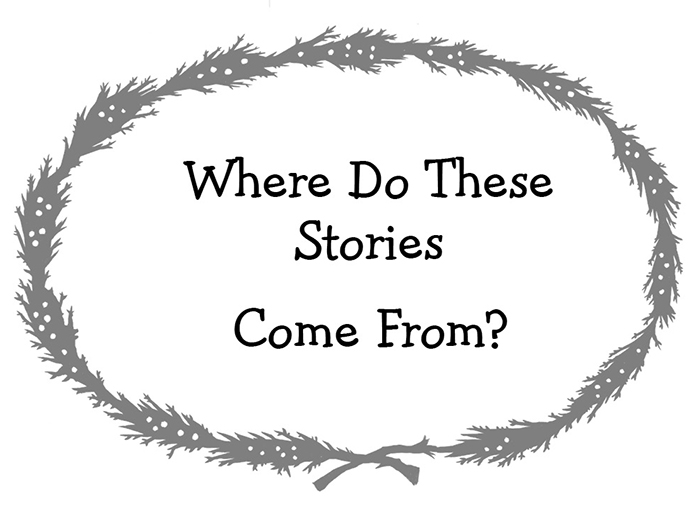The Grimm Conclusion (20 page)
Read The Grimm Conclusion Online
Authors: Adam Gidwitz

Wait! I forgot! One last thing!
Every once in a while, Jorinda and Joringel venture back into the Märchenwald. They come to see me.
And also Hansel and Gretel.
And Jack and Jill.
Yeah, I know them, too.
And I order pizza, and we all sit and tell each other stories until the sidewalks are empty, and the sirens stop their wailing, and the sun rises over the bleary streets of Brooklyn.
Which is, of course, how I learned all these tales to begin with.
And now it really is,

Probably.

Y
ou should have your own beloved book of Grimmâa tome that you turn to in search of humor, solace, and nightmares. I have mine. It's a large, red, tattered, cloth-covered volume, translated by Ralph Manheim. I love Manheim's style: lyrical simplicity, I'd call it. I have thrice quoted him verbatim in these pages: in the passage describing the mother's pregnancy (
here
) and when Briar Rose's castle falls asleep and then awakens (
here
and
here
).
The chapter
Jorinda and Joringel
has nothing in common with the Grimm tale “Jorinda and Joringel” save the names of its protagonists and the love they feel for one another. While I like the Grimm tale a lot, I chose not to retell it. I did choose, though, to steal those two names. I mean, Jorinda and Joringel? How could I not?
The chapters
Jorinda and Joringel
and
The Juniper Tree
are really two halves of the Grimm tale “The Juniper Tree.” My favorite version of that tale is the translation by Lore Segal, illustrated by the incomparable Maurice Sendak.
The chapter
Ashputtle
is a near verbatim transcription of my retelling of Grimm's “Ashputtle.” If you've ever heard me speak to children, you've likely heard the exact words from the chapter, delivered amid a torrent of children screaming. The passage about chamber pots and ashes and cinders was suggested by Laura Amy Schlitz; while I haven't followed up this particular point with proper research, it is far too good to omit.
The Three Hanging Men and Malchizedek's Mansion
are two halves of the same Grimm tale, “The Boy Who Left Home to Find Fear.” I came across the name Malchizedek when visiting a medieval church. Melchizedek [I changed the spelling] is a priest mentioned in the Bible. There was a picture of him on the walls. He looked kind of scary. Also, like Jorinda and Joringel, his name was too awesome not to steal.Â
The chapter
Sleeping Beauty
was inspired by the Grimm tale “Briar Rose.” While the ridiculous golden plates scenario is absolutely original, I changed her affliction as well as the resolution of the story. That she is woken by a chunk of apple being dislodged from her throat, instead of being kissed, comes from the Grimm version of “Snow White.” Also kissing is gross.
The Little Foal
is inspired not by any Grimm tale, but instead by a story from Peter Dickinson's book
Merlin Dreams. Merlin Dreams
is currently, cruelly, out of print. I hope someone rectifies this, as it is one of my very favorite collections of stories.Â
The Ivory Monkey
(and its reprise in Hell) was inspired by Eric A. Kimmel's retelling
Anansi and the Moss-Covered Rock.
Before any of my work was published, and having attempted my very first adaptation of a Grimm story, I wrote to Mr. Kimmel and asked him for advice. He gave me both advice and encouragement. It is amazing when your literary heroes turn out to be heroes in real life, too.Â
The stack of mattresses that serves as a theme throughout, and is realized in the chapter
The Tyrants,
was suggested by the Hans Christian Andersen story “The Princess and the Pea.”
The remaining chapters are based on sawdust and spit and experience. Sammy and George and Jeff were actual students of mine, but they never did anything quite as bad as I describe in this book. Except for Jeff, who really did glue cotton balls to his face.
Sometimes people ask me why dark fairy tales have enjoyed such a renaissance of late. I think the reason is this:
Most fairy tales have roughly the same structure. A hero faces a problem at homeâshe's poor, he's the neglected youngest son, their parents are trying to murder them, etc. The hero leaves home and ventures into a strange worldâoften a forest. In the forest, the hero faces dangers and difficultiesâweird, frightening, and grimâand ultimately overcomes them. Finally, the hero returns home, stronger, richer, and wiser.
Being the reader of a dark fairy tale is much like being the hero of one. Our lives are filled with pain, boredom, and fear. We want to venture into the dark wood, to see the oddities and the beauties it holds, and to test ourselves against them. So we pick up a book of fairy tales. The real ones. The weird ones. The dark ones. We see oddities and beauties galore. We test our courage and our understanding. Finally, we put the book down and return to our lives. And hopefully, just like the hero of the fairy tale, we return stronger, richer, and wiser.
In difficult timesâof recession and violence and political bitternessâwe long for a dark forest to which we can escape; and from which we can return, better than we were before.
Acknowledgments
I would like to thank my mother and father for teaching me how to write.
My mother taught me to write in the fifth, sixth, and seventh grades. Rather than allowing me to type my own essays, she would insist on taking dictation from me, freely editing my words and ideas as I spoke. I learned a great deal about quality and content and rhetoric from these sessions. And of course, my essays during this period were brilliant, because my mother has a PhD.
My father's instruction began in eighth grade. I would write an essay, bring it to my father, and then I would run back to my room and shut the door and pray. Then I would hear, “ADAM!” I would slink down to my parents' room, where my father was sitting in a great big chair and staring at the essay. I would stand before him, andâevery time, without failâhe would intone, “Tell me what you were trying to say.” It was usually at this point that I began to cry. Because I knew that the next three to six hours would be devoted to writing and rewriting and rewriting again.
If it weren't for these experiences with my father, I know I would not be a writer today, because my editor, the brilliant Julie Strauss-Gabel, has standards even higher than my father's. Yes, she makes me cry sometimes. But I love her for it. And my readers should, too.
My little brother did not teach me how to write. He taught me just about everything else of importance, though. The relationship between Jorinda and Joringel is drawn, in no small part, from ours.
Sarah Burnes, my agent, found me in a first-grade classroom and changed my life, like some Wise Woman from a fairy tale. I will never be able to thank her enough.
The team at Penguin has also been utterly
magical. As has my assistant, Vanessa DeJesus.
And Lauren Mancia, my wife, reads my books before they are books, when they are malformed and protean and nonsensical. And she is honest with me about how malformed and protean and nonsensical they are. Which I don't really like. But she also laughs out loud at the jokes in my books. And for that I am eternally, profoundly grateful. For that and for everything.

